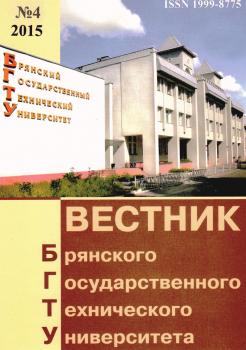National Research Nuclear University “MEPhI” (Professor)
Bauman Moscow State Technical University (Professor)
Bryansk, Bryansk, Russian Federation
Many factors affecting considerably surface wear cannot be taken into account within the bounds of existing approaches to the mathematical description of this process. It is wellknown that the modes of finish grinding have a significant influence upon wear resistance of a friction surface. It is explained, for example, by differences in a structural – phase state of a surface layer formed in the course of thermal and force impact of abrasion. Therefore, for reliable fore-casting of the resource of many tribo-couplings it is necessary to estimate friction surface wear resistance taking into account the influence of conditions and modes of finishing abrasion. The mathematical modeling of the process un-der consideration allowed obtaining an equation for the computation of a wear rate of run-in ground friction surfaces and nonrunin ones in which pressure in a contact, slip velocity, abrasion modes, form errors in a friction surface and also a state of a surface layer and a position error of a friction surface in a coupling are taken into account. Experimental researches have confirmed a possibility of use in practice the mathematical depen dences obtained. The researches carried out allow forecasting more reliably ground friction surface wear of machinery and mechanisms.
friction surface, surface wear velocity, mathematical modeling, abrasion
1. Bishutin, S.G. Wear Resistance of Machinery Surface Layers Formed at Grinding: Monograph/ S.G. Bishutin, M.I. Prudnikov; under the editorship of S.G. Bishutin. - Bryansk: BSTU, 2010. - pp.100.
2. Bishutin, S.G. Quality and Wear Resistance of Ground Surfaces in Motor Car Parts/ S.G. Bishutin. - Bryansk: Desyatochka, 2011. - pp. 100.
3. Gromakovsky, D.G. Physical fundamentals, mechanics and technical applications of tribology: Lecture Course for Technical Colleges/ D.G. Gro-makovsky. - М.: Mechanical Engineering, 2006. - pp. 266.
4. Chichnadze, А.V. Fundamentals of Tribology (Friction, Wear, Lubrication): Textbook of Technical Colleges/ А.V. Chichnadze, E.D. Brown, N.А. Bushe [et al.]; under the general editorship of A.V. Chichnadze. - М.: Mechanical Engineering, 2001. - pp. 664.
5. Kragelsky, I.V. On wear computation of friction surfaces / I.V. Kragelsky, G.M. Kha-rach//Computation Methods for Friction and Wear Estimate: Proceedings - Bryansk: Prioksk. Publish-ing House, Bryansk Branch, 1975. - pp. 5-47.
6. Kragelsky, I.V. Machinery Friction Units / I.V. Kragelsky, N.M. Mikhin. - М.: Mechanical Engineering, 1984. - pp. 280.
7. Myshkin, N.K. Friction, Lubrication, Wear. Physical Fundamentals and Technical Applications of Tribology/ N.K. Myshkin, М.I. Petrokovets. - М.: Physmathlit, 2007. - pp. 368.
8. Tribology Fundamentals: Textbook for Technical Colleges/ under the editorship of А.V. Chichnadze. - М.: Science and Technics, 1995. - pp. 778.
9. Bishutin, S.G. Assurance of Required Quality Parameter Totality for Parts at Grinding / S.G. Bishu-tin. - М.: Mechanical Engineering-1, 2004. - pp. 144.
10. Bishutin, S.G. Surface Layer Structuring of Parts at Finish Abrasion/ S.G. Bishutin. - Bryansk: BSTU, 2009. - pp. 100.














